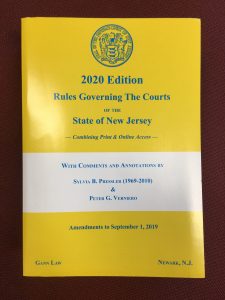You know the feeling. Like clockwork a favorite relative sends you a birthday card year after year, often days if not weeks before your actual birthday. Then one year your birthday comes and goes and no card was received from that relative. You are filled with feelings of surprise and disappointment. What happened? Did the relative forget? Is the relative upset with me? For whatever the reason, you feel a sense of loss. For those of you who are regular readers of my blog posts, you know that in the Fall of each year, like clockwork, I write a series of posts summarizing recently promulgated amendments to the New Jersey Court Rules that would directly or indirectly impact Family Court matters. Like the expected birthday card that was not received, I am sure you are surprised and disappointed that I have yet to do so. However, like the belated birthday card that arrives weeks later, this blog post is just what you are waiting for. Candidly, however, it is more like getting a card without the expected check inside. Why? Whether due to the COVID pandemic or other reasons, there were an unusually small number of changes or amendments made to the Court Rules for this year, none relating to the Part V Family Part Rules, and few even indirectly impacting Family Court practice. However, there was one new Rule which was adopted, which although procedural in nature, could directly impact how Family Court matters are handled, particularly those unresolved matters for which a trial may be necessary. What you may ask? We finally have a Rule dealing with in limine motions.
I know. I know. You are asking what in the world is an in limine motion, and why does it deserve its own Rule? Over the years, in limine motions have come to resemble the “Wild Wild West” of motion practice. Generally speaking such in limine motions were made on the eve of and/or at the outset of a trial. Often they sought to address various evidence-related issues, such as whether certain evidence should be allowed and/or excluded from consideration during the trial. However, motions labeled as “in limine” were also being filed for the purpose of having a court make a determination on certain substantive matters such as whether a certain claim or issue would be granted or excluded from a case. For example in the Family Court context, a party may make a motion in limine as to whether or not a certain asset should be deemed exempt from equitable distribution in the hopes of “limiting” the issues to be addressed at trial. Often such in limine motions were made within days of, if not on the day of trial itself, leaving the opposing party with nominal opportunity to prepare and respond to same. How such motions were handled were largely left to the discretion of the trial court. While less so in the Family Court context, such in limine motions were being filed, the disposition of which could actually result in the dismissal of a complaint or claim, or of a defense thereto. Ultimately, several court decisions were rendered making clear that one should not be able to disguise what was in effect a “summary judgment” motion as a motion in limine, and that such motions must utilize the timing and notice requirements for summary judgment motions under R.4:46. Unfortunately, notwithstanding these admonitions against the misuse of the in limine motion practice, these abuses continued.
In the case of Seoung Ouk Cho v. Trinitas Regional Medical Center, 443 NJ Super 461 (App. Div. 2015); cert. denied, 224 NJ 529 (2016) the Appellate Division appeared to reach a breaking point when it came to this use and abuse of in limine motion practice and the lack of any rules or guidelines respecting same. In this medical malpractice case, the defendant doctor made a motion “in limine” on the day before jury selection was to begin to dismiss the claims against him. Although initially questioning whether this was a proper “in limine” motion, the trial court ultimately granted that motion. The Appellate Division reversed. In so doing it noted:
 New Jersey Divorce and Family Lawyer Blog
New Jersey Divorce and Family Lawyer Blog








